Why a reasonable price for photographers is justified
I’m a real estate photographer in Berlin and I’m writing this post for everyone who wants to know what a real estate photographer or architectural photographer actually does. More specifically, in this post I would like to explain why a reasonable price for real estate photos is absolutely justified. When a photographer sends an offer to a customer, they often say: “he only takes photos – I can do that myself with my cell phone”. … I hope that I can bring a little light into the darkness with this article.
It should be noted: I write about my personal view and my situation as a real estate photographer in Berlin. However, I am sure that I speak from the soul of many professional photographers here.
What do I actually do as a real estate photographer?
The opinion of most people is the following: The real estate photographer (or architectural photographer) appears at the object on the agreed date. There, in the first room, he unpacks the camera, sets it up on a tripod, pulls the trigger, and that’s it. Off to the next room. There, the whole procedure is repeated until the property is “in the box” in the shortest possible time.
After that, the photographer goes home and uploads the images to his computer, and then sends them to the client in no time.
If this workflow were true to reality, my job as a photographer would be a breeze.
Reality:
First, let me state the following facts.
It’s the photos of an apartment ad or a web store; it’s the imagery of a commercial that piques the interest of potential customers. The willingness to buy increases through corresponding images. In my previous life as a packaging engineer and packaging designer, I know: our subconscious mind decides in less than a second whether a product will eventually end up in our shopping cart or not.
And that’s exactly how it is with real estate photos. Except that real estate photos are not a supermarket item for a few euros. Here, we are talking about 6- or 7-digit amounts, as is generally known. Keeping these values in mind, the photographer has a very high responsibility! The photographer is the entity that takes the exact photos that appeal to customers or buyers.
What are the activities of a real estate photographer?
First, the photographer must find the right perspective and angle for each photo. For me personally, photography is not working off or “painting by numbers”. I want to tell a story with my pictures and that the viewers of my pictures understand the property emotionally and rationally. My ambition is that the viewers do not experience an illusion, but an actual representation of reality through my pictures. The right perspective and the right angle of view are war decisive for a successful photo.
In connection with the perspective is the so-called “staging”. Here, too, I bear full responsibility as the photographer: Should the flower vase on the table be further to the left or to the right? Or should she be in the picture at all? Do I leave 4 or 6 chairs at the dining table, and should the yellow pillow stay on the sofa or does that interfere with the impression I would like to give, and and and. Many decisions have to be made in a very short time. Decisions of a technical AND design nature.
After the right perspective has been found and all the props have been placed in the right place, the picture must of course be taken. Here, the illusion most people have is that the photographer snaps a photo, and the image is ready. In rare cases, that may be true.
Some also think that the photographer is doing an automated HDR. This is also wrong – at least in my case.
The reality of most pictures looks like this: The photographer takes several photos of the same perspective while the camera is firmly fixed on the tripod. The images differ by different brightnesses or by using flashes in certain places. Some of my shots consist of 5-10 individual photos. These individual photos are then painstakingly stitched together manually on the computer to create the final photo.
While the shot is being taken and flashes are being used, for example, I need to know exactly what the final image will look like. The incidence and direction of light must be logical and coherent. At the same time, the image should look natural and not like an artificial flash parade. So the same applies here: I have to make a lot of decisions in a very short time. I have to blindly master the technology of my equipment. I have to shoot everything according to my vision in order to be able to create a high-quality image in post-processing. The horror would be to realize, when post-processing the images at home, that you forgot a crucial frame.
Post-processing:
Once you have everything photographed, you go home to edit the pictures. What most people don’t know: Post-processing the photos takes a lot of time. Likewise, few people know that technical as well as creative and artistic skills are extremely important here. Multiple software applications must be mastered. At the same time, the photographer’s creative marketing eye and artistic eye are war deciding factors at this stage. The different exposures you had according to your own vision at the shoot now become tangible results. Since pictures speak louder than words, I’ll show you an example. Here I took several individual shots and used my flash to set many accents according to my vision of the final image:



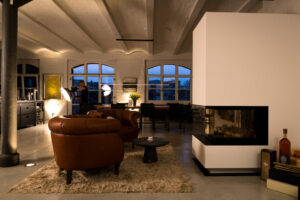

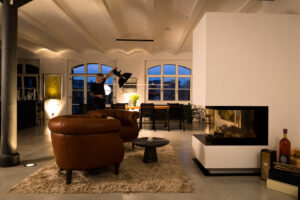
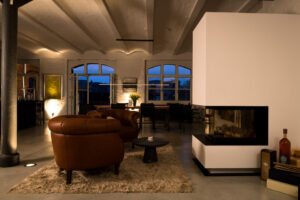
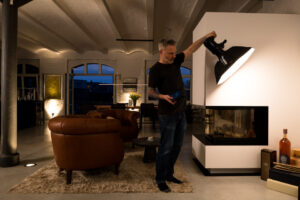
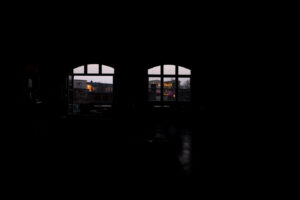
From these photos I then created the following image:

I think this gives you a little insight into how I work and the quality of my images compared to automated HDR shots.
HERE
you can see more interior shots from my portfolio
Equipment
What I haven’t mentioned yet is the photo equipment.
I could rave about my equipment for hours! I love every lens, every camera, every flash, my Macbook; even my backpack. However, when I look at it unemotionally, this is all just my work tool. Work tool that costs money. A lot of money! And here we are again on the subject: with every job, the equipment gets worn out. Sometimes even things get broken. All of these are additional factors that you should have in mind when hiring a professional photographer and possibly stumbling upon their prices.
In terms of equipment, in my case, I don’t just need a camera, a lens and a tripod. I control my camera with an iPad. This way I don’t have to press the button on the camera and thus avoid camera shake. However, for me this means that I also have an iPad and a “camranger” (=modem that connects the iPad to the camera) in my luggage. It all costs money.
As a real estate photographer in Berlin, I travel to all assignments by public transportation. Why? I do not have a car. I also don’t want to have a car as long as I live in Berlin. When you have such a good public transport network in the city, you don’t have to put an extra burden on the environment. So with my jobs, there’s always an additional “workout” as well – and my jobs are almost carbon-neutral.
Almost climate neutral? Yes – because before each job, of course, all the batteries still have to be charged. With rising electricity prices, this is also a cost factor in the long run, which is not insignificant.
Even if this post may sound different: I love my job as a real estate photographer in Berlin and all its facets. I am not writing this to complain, but to explain to you what is actually behind the term “real estate photographer”.
Or much more, what real estate photographers are all about, the talents they bring to the table, and the importance of their work. Keeping in mind the fee rate of an agent selling a property, there should be enough money left over at the end of the day to pay a photographer fairly and appropriately for good photos. The same applies, of course, to real estate companies or property management companies.
Real estate photographer in Berlin but…
I am a real estate photographer in Berlin – but I can also be booked throughout Germany or worldwide.
I also have a business as a wedding & portrait photographer – for more info please click here:
www.trumpp-exposures.de

